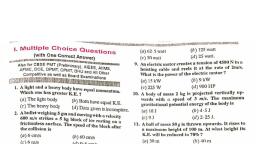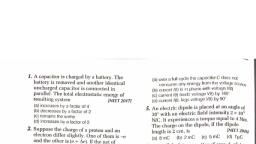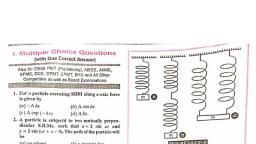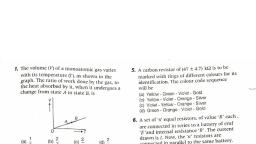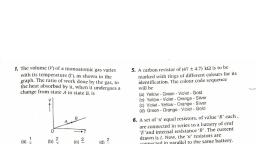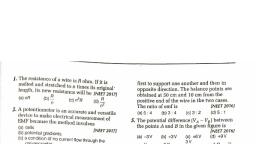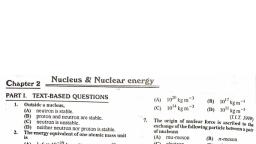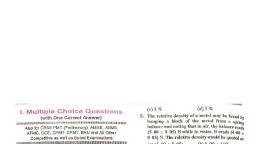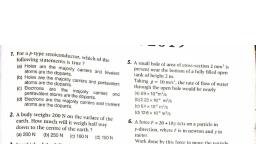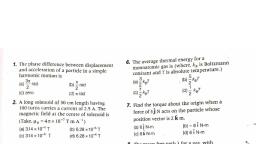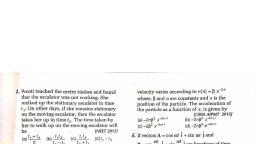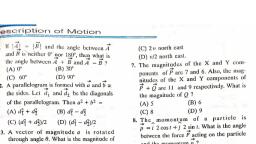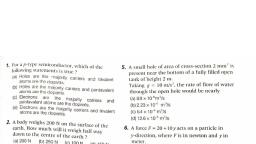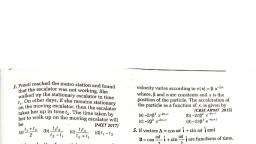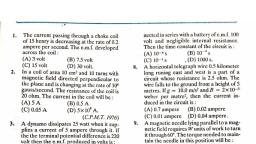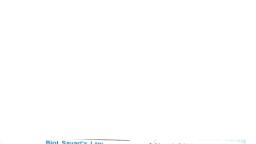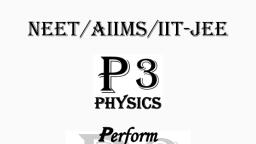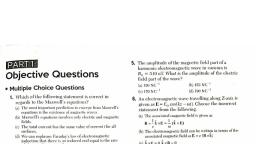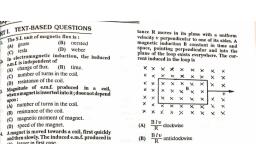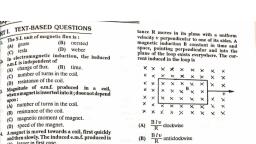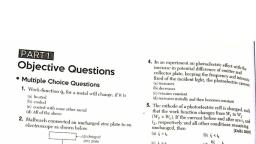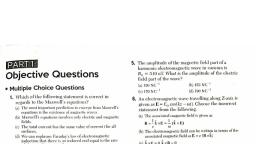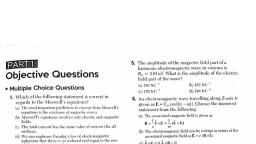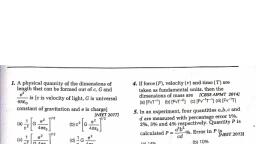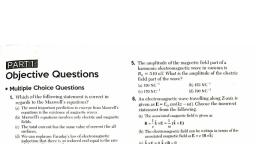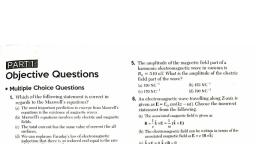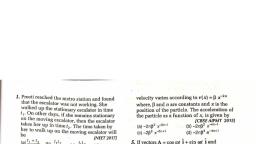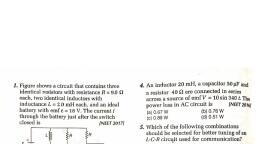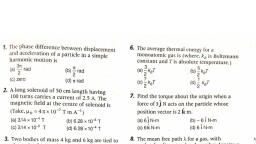Page 1 :
4. In an experiment on photoelectric effec with th,, le, , . e . increase in potential difference of emitter, Objective Questions collector plate, keeping the frequency sate :, fixed of the incident light, the Photoelectric ge, (a) increases reat, decreases, , ic} remains constant, (d) increases initially and then becomes constant, , , , , * Multiple Choice Questions, , Te Work-function %, , for a metal will change, if it is, fa) heated, , {b) cooled 5. The cathode of a Photoelectric cull is changed, such, ‘c) coated with some other metal . that the work function changes from W, to W,, (d) All of the above (W, > W, ). Ifthe current before and after are, and, ) Tespecti' ya it i it, 2. Hallwach connected an uncharged zine plate to an & ooeaivey: and all other conditions ae, electroscope as shown hele unchanged, then (Delhi ata), ley (a) hme ) §<4, —Uncharged . ;, ainc plate {c} i >a, (dy 4 = 7", 2 2, , 6. In photoclectric effect experiment, collector plate, is made negative with respect to emitter plate as, shown in figure below till it reach a certain, , ra i, This plate is then irradiated by UV-light. The result Potential Vq, when photocurrent a, , of this is correctly shown in, , FatEe eS, (a) (h) /\, Vo, IF K indicates kinetic energy of an emitted |, +++, (o) (d) photoelectron, then at point P, (a) K > ev, (b) K<ev, ‘gi, , , , Emitter plate, , , , , , , , (c) K=eV, (d) O< KEeVy, 7. Consider a beam of electrons (each — with j, i Sp) inci tina, non of electric discharge through energy E) incident on a metal surface bo 3, ” bn eco the coloured glow in the tube evacuated chamber, then [NCERT Ew 4, msoret a ahr of {a) no electrons will be emitted as only photons can emit, Bppemr ah . electrons, S eerie: (b) electrons can e — sos with an nares Be, = ° " «mitted from the {c) electrons can be emitted wit 1 any energy,, (c) collision between the charged particles emitted from ) muendiet deat, , p the atoms of the gas, (d) pr sen oa different electrons of the atoms of the, d is, , gas, , (d) electrons can be emitted with any energy, witha, maximum of E
Page 2 :
Ja for kinetic miss of a moving photon is, > p The for i Planck constant and v, A, care, , whe ee wavelength and speed of photon,, thy dite, , leh hivie (dy hiecd, , s wavelength of a photon needed to remove a, 9 ee from a nucleus which is bound to the nucleus:, , , , with | MeV eneryy is nearly [NCERT Exemplar}, er db) 122610 9m, pl «10% nm (d} 1.2100, , , , 9, A point source of light is used in an experiment on, ; photoelectric effect. Which of the following curves, jest represents the variation of photoelectric, , , , , , current i with distance s of the source from the, ernitter?, 2, :, 5, =, £3, Distance *, faja th) b, fle (dj a, , 11. Variation of photoelectric current with collector, plate potential for different intensities I,and I,, (such that f, > 7, )at a fixed frequency és, , , , potential, , , , Vy [0 Colector plate, potential, , patertial, , 12. The figure shows a plot of photocurrent versus, anode potential for a photosensitive surface for, three different radiations. Which one of the, following is a correct statement?, , Photocurrent, , b., Cc. a, , Astarding potential Anode potential, , , , rad, (0) Corves a and b represent tieident radiati, frequenetes and different intensities, a, , th) Curves a and Jy represent incident radiations ul same, frequeney but af different intensities,, , fe} Curves b amd ¢ represent invident rediations oof Oifferest, Frequencies and different intensities., , (d) Curves band ¢ represent incident radiathons af same, frequency having same intensity,, , 13 The value of stopping potential Vo from the given, graph is {AM Incin 2020), , , , , , {a} -0.54V, (c) O2V, , (by O54, , {d) -02V, , 14, A student plot « graph while performing an, experiment on photoelectric effect using an, evacuated glass tube, for light radiation of same, intensity at various frequencies as shown below, , |v, , ‘2, D —e, , Ilere,, , {a} X + Photoclectric current: ¥ > Retarding, potential; Z >, Stopping potential, , {hb}. X — Returding plate potential; ¥ + Photocurrent; Z—, Stopping potential, , (c) X 9 Collector plate patential; ¥ — Photocurrent; 2, Saturation current, , (d) X 3 Retarding plate potential; ¥ — Phatocurrent; Z =>, Saturation ewrrent, , 15. ‘The photoelectric threshold wavelength for silver is, dy. The energy of the electron ejected from the, surface of silver by an incident wavelength, , AA < hg) will be [AU India 2020), y=?) h( dy -®, inte =) wi(ss), a by he (ag 2), Or (d) he (hy
Page 3 :
16. A square current carrying loop is, Suspended ina uniform magnotic fiald, aeting tn the plane of the loop. If the force, on one arm of the loop is F, the net force, on the remaining three arms of the loop is, (CBSE AIPMT 2010], , (c) OF (a) F, , 17. The magnetic force acting on u charged, particle of charge — 2 in a magnetic field, of2 Tacting in wedirection, when the, particle velocity is (2143) x 10 ms” is, (8) 8 N in sdirection [CBSE AIPMT 2009}, (0) 4.N in z-direction, (C) 8 N in y-direction, (9) 8 N in z-direction, , (a) 3F (b) -F, , 18. A particle of mass m, charge q and kinetic, energy T enters a transverse uniform, magnetic field of induction B, After 3 s, the, kinetic energy of the particle will be, , [CBSE AIPMT 2008}, (a) aT (b)27 (oT (d) 47, , 19. A closed loop PQRS carrying a current is, placed in a uniform magnetic field. If the, magnetic forces on segments PS, SR and, RQ are F,, F, and F, respectively and are in, the plane of the paper and along the, directions shown in figure, the force on the, , segment QP is (CBSE AIPMT 2008], Q, Pp, F3, Fy, s R, Fe, , (af, -F, -F, (b) VF, - AYP + FF, , Ov-AY-F GW A-R+e, 20. A beam of electrons passes undeflected, through mutually perpendicular electric, and magnetic fields. If the electric field is, switched OFF and the same magnetic field, is maintained,the electrons move, i ie = AIPMT 2007], elliptical orbit 4 Circular orbit, f wrong a parabolic path (d) along a straight ine, , 21. A charged particle (charge q) is movin, circle of radius R with uniform speed _ a, The associated magnetic moment p jg Biven, , by (CBSE AIPM 20991, 2, (a) a8 (o)qvR? —(c) i (ava, , 22, Under the influence of a uniform magnetic, field a charged particle is moving in g circle, of radius R with constant speed v, The time, period of the motion ICBSE Alp 2007), , (a) depends on v and not on R, , b) depends on both A and v, o is independent of both A and v, , (Gd) depends on Af and not on v, , 23. Two circular coils 1 and 2 are made from, the same wire but the radius of the 1st coil, is twice that of the 2nd coil. What is the, ratio of potential difference applied across, them so that the magnetic field at their, centres is the same ? (CBSE AIPMT 2006], (a)3 (b) 4 (c)6 (a2, , 24, When a charged particle moving with, velocity v is subjected to a magnatic field, of induction B, the force on it is non-zero,, This implies that [CBSE AIPMT 2006}, (a) angle between v and Bis necessarily 90°, (6) angle between v and B can have any value, other than 90°, , (c) angle between v and B can have any value, other than zero and 180°, , (¢) angle between v and B is either zero ‘or 180°, , 25. An electron moves in a circular orbit with, a uniform speed v. It produces a magnetic, field B at the centre of the circle. The, , radius of the circle is proportional to, (CBSE AIPMT 2005}, , 8 v v 8, @~ 5 (c) \5 (d) e, , 26. A coil in the shape of an equilateral triangle, of side / is suspended between the pole, Pleces of a permanent magnet such that Bis, in plane of the coil. If due to a current j in, the triangle a torque tacts on it, the side / of, , the triangle is [CBSE AIPMT 2005], 2 t v2 2 t, “a(5) , Pals), (2(_t } =, (as Ow
Page 4 :
4 Jong solenoid Carrying a cy, produces a Magnetic field B along ; ‘, ifthe current is doubled and ities axis,, turns per cm is halved, t ber of, , he new, the magnetic field is Kase of, , AIPMT, age (b) 48 7008), () 5 (JB, , qf. Trent, , d particle moves th, , 38.8 charge parti _—s, magnetic field in a direct; a ;, , toil. Then, the Perpendicular, , ICBSE Alpy, (a) acceleration remains unchanged ea, , (b) velocity remains unchanged, () speed of the particle remains unchanged, (d) direction of the particle remaing unchanged, , Tegion where electric, eld Bboth exist, then, , 29. Acharge q moves in a, field E and magnetic fi, , the force on it is ICBSE AIPMT 2002), (a)q(v xB) (()\GE+q (v xB), ()q B+ Q(B xv) (igB+qExv), , 50. The magnetic field of a given length of wire, carrying a current for a single turn circular, coil at centre is B, then its value for two, turns for the same wire when same current, , passing through it is [CBSE AIPMT 2002], B 8, e b) 2, , (a) a (b) 2, , (cj2B (d) 48, , 51. A charged particle of charge g and mass m, enters perpendicularly in a magnetic field, B. Kinetic energy of the particle is £, then, , frequency of rotation is [CBSE AIPMT 2001], 8, , a q8 QBE gy 98, , Ome 2am eam Dee, , 32, Current is flowing in a coil of area A and, number of turns N, then magnetic Smee, of the coil, M is equal to [CBSE AIPMT 2, , @NiA (by x ©) a (a) A, , & Two wires are held perpendicular . the, Plane of paper and are 5 m apart. T <A, carry currents of 2.5 A and 5 A in sa direction, Then, the magnetic field streng, , Bi . idwav between the wires, , A a point midway TCBSE PMT 2008], i... dail Sot (a) SHOT, , eat (o) 507 Os5 an, , 34, Magnetic field du, , 411, , c € (0.0.1 A current flowing, , : Tough a circular coil of radius 0.1m and, 900 turns at the Centre of the coil is, , 027 [CBSE AIPMT 1999], , (b)2 x10" T, (C) 628 x 1047 (d) 98 x 104 T, , 35. Ifa long hollow copper pipe carries a, , current, then magnetic field is produced, , {a) inside the pipe only [CBSE AIPMT 1999], (b) outside the pipe only, , (c} both inside and outside the pipe, , (d) no where, , 56. Two long parallel wires are at a distance of, , 1 m. Both of them carry 1A of current. The, force of attraction per unit length between, , the two wires is ICBSE AIPMT 1998], (a) 2 x 107? Nim (b)2 x 107° N/m, (c) 5x10 Nim (d) 1077 N/m, , 37. A coil of one turn is made of a wire of, , certain length and then from the same, length a coil of two turns is made. If the, same current is passed in both the cases,, then the ratio of the magnetic induction at, their centres will be [CBSE AIPMT 1998], (aj2:1 (o) 1:4 (c) 4:1 (a) 1:2, , 38. A positively charged particle moving due, , east enters a region of uniform magnetic, field directed vertically upwards. The, particle will [CBSE AIPMT 1997], (a) continue to move due East, , (6) move in a circular orbit with its speed unchanged, (c} move in a circular orbit with its speed increased, (d) gets deflected vertically upwards, , 39. Two equal electric currents are flowing, , perpendicular to each other as shown in the, figure. AB and CD are perpendicular to each, other and symmetrically placed w.r.t the, currents, where do we expect the resultant, magnetic field to be zero ? [CBSE AIPMT 1996], , , , (a) On AB (b) Onc2 80, (c) On both ABand cD (qj On batho? and
Page 5 :
se iat ‘ i for the, 40. Which of the following are suitable, fusion process ? [CBSE AIPMT 2002], , (a) Light nuclei, , (b) Heavy nuclei emis, , (c) Elements lying in the middle of periodic, (d) Elements lying in the middle of binding energy, , curve, 41. A sample of radioactive elements contains, 4x 10*° active nuclei. If half-life of, element is 10 days, then the number of, decayed nuclei after 30 days is, , [CBSE AIPMT 2002], (a) 0.5 x 10'° (b)2 x 10, (c) 3.5 x 10" (d) 1x 10'°, , 42.In compound X(n,a)— ,Li’, the element, Xis [CBSE AIPMT 2001], , (a) jHe* = (b) ,B"?— () ,B® (d) ,Be™, , 43. Half-life of a radioactive substance is 12.5, h and its mass is 256 g. After what time,, the amount of remaining substance is 1g?, [CBSE AIPMT 2001], (a) 75h (6) 100h = (c) 125h (d) 150h, 44, Half-life period of a radioactive substance, is 6 h. After 24 h activity is 0.01 uc, what, was the initial activity? (CBSE aipyyt 2001], (a) .04uC (6) 0.08uC (c)024uCc (a) O16 uc, , 45. In nuclear fission process, energy is, , released because [CBSE AIPMT 2001], (a) mass of products is more than mass of, nucleus, , (b) total binding energy of products formed due to, nuclear fission is more than the Parent, , fissionable material
